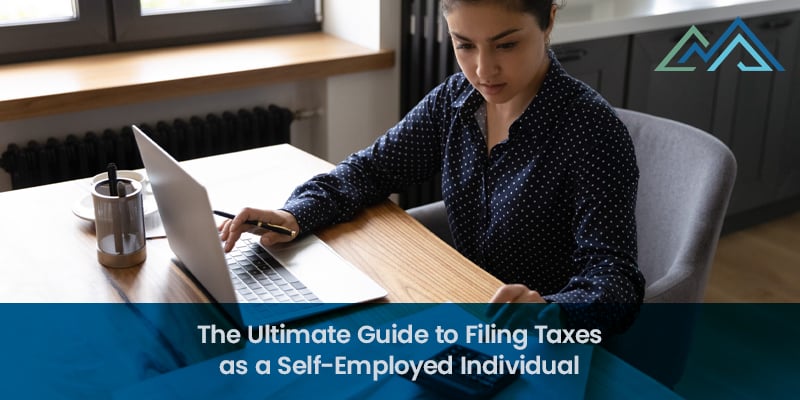We live in a world where it has become increasingly common for people to find ways to work for themselves. As of 2023, a study published in Bloomberg found that up to 15% of Americans were employed as individual contractors. That number includes those who work for themselves full-time and those who have side gigs.
At CMP, we work with self-employed individuals daily to help them understand the ins and outs of paying taxes. Since working for yourself can be expensive, we’ve created this guide to help you understand how to properly report, file, and pay your self-employed taxes—without paying more than you need to.

What Is Self-Employment Tax?
The self-employment tax is something that is often misunderstood. Whether you work for a company or yourself, you must pay Medicare and Social Security taxes. If you work for an employer, they pay a portion of your Social Security tax and deduct your portion, plus your Medicare taxes, from your paycheck.
When you are self-employed, you must pay both the employer’s and the employee’s portion of the Social Security tax, plus the Medicare tax. You are also required to pay income tax. This means that as a self-employed individual, you have a higher tax burden than someone traditionally employed. You may also be eligible for deductions and credits that aren’t available to others, which is why we recommend working with a tax professional to ensure you don’t pay more than you need to.
Self-Employment Tax Rate
One of the most common questions we hear about self-employment is this:
What is the self-employment tax rate?
Before we explain the steps to filing taxes as a self-employed individual, here’s the breakdown of self-employment taxes. The total percentage is 15.3%, (as of 2024), which includes the following.
- 12.4% for Social Security
- 2.9% for Medicare
We should note that high-income earners may also be subject to the Additional Medicare Tax of 0.9%. This tax applies to individuals with income above $200,000 and married couples filing jointly with income above $250,000.
There is a threshold for payment of the self-employment tax. You must pay the 15.3% self-employment tax on income up to $168,600 when you file your 2024 taxes. That’s an increase from $160,200 for 2023.
Filing Taxes as a Self-Employed Individual: A Step-by-Step Guide
Since filing taxes as a self-employed individual can be complicated, here is our step-by-step guide to help you through the process.
1. Understanding Your Self-Employed Status
The first step is to make sure you understand your self-employment status. According to the Internal Revenue Service, you are self-employed if the following things apply to you.
- You do business as a sole proprietor or an individual contractor.
- You are part of a partnership that conducts trade or business.
- You are otherwise in business for yourself (including part-time or gig work.)
Remember, you must report self-employment income to the IRS and pay taxes even if it’s not your full-time job.
2. Make Quarterly Estimated Tax Payments
Any self-employed person who owes more than $1,000 in taxes for the tax year must estimate their income and make quarterly estimated tax payments. Doing so will minimize the risk of incurring any late fees or penalties. You’ll need to plan for these payments to ensure you have the money to make them on time.
You must use Form 1040-ES to report and pay your estimated quarterly taxes. It’s essential to be as accurate as possible. If you underpay your quarterly taxes, you’ll have an additional tax bill when you file your tax return. If you overpay, you can get your money back as a tax refund.
3. Total Your Income
Keeping track of your self-employment income is necessary because you must report it to the IRS and calculate your taxes. Depending on your type of work, you may receive Form 1099 from the people who hire you to do work for them. There are multiple variations of Form 1099, including 1099-NEC for non-employee compensation.
If you have a part-time gig, such as selling products online, you may not receive a Form 1099. Even if you don’t, you must still track your income. Gather all 1099 forms and other income and total them to make sure you have an accurate amount before you take the next step.
4. Track Your Expenses
One of the best things about being self-employed is that, in many cases, you may deduct business expenses to offset the amount of tax you’re required to pay. Here are some expenses that may be deductible:
- Business use of your home
- Business equipment
- Work-related education
- Office Supplies
- Professional memberships
- Car expenses or mileage
- Depreciation of property and equipment
- Other expenses, including marketing, banking fees, and travel expenses
- Health insurance
If you use your car for your business, you’ll need to choose between taking the standard mileage deduction or tracking your actual expenses.
5. Calculate Your Net Profit or Loss
To calculate your net profit or loss, take your gross self-employment income, and subtract your deductions.
You don’t need to take this step separately from filing your tax return, but you should if you think you have spent more than you took in since you can use the loss to offset the amount of tax you’re required to pay.
Keep in mind that you can take the standard deduction when you file your taxes and still deduct certain business expenses. Working with a qualified tax professional will help you take advantage of all available deductions and credits.
6. Calculate Your Self-Employment Tax
You must pay self-employment tax on your net earnings, meaning your gross earnings less any deductible expenses. The rule is that generally, 92.35% of your net earnings are subject to self-employment tax, so you will need to do the calculation as follows:
Net self-employment income X .9235 = Self-employment taxable income
For an individual who earns $60,000 of net self-employment income, the taxable income would be $55,410. If we multiply that number by 15.3%, they will owe a self-employment tax of $8,477.73.
7. Complete Your Income Tax Return
Completing your federal income tax return requires completion of Form 1040 as well as some additional forms, including the following.
- Schedule SE (Self-Employment Tax)
- Schedule C (Profit or Loss from Business)
- Schedule 1 (Additional Income & Adjustments to Income)
You’ll use Schedule SE to calculate your self-employment tax, Schedule C to calculate your business profit or loss, and Schedule 1 to report your profit or loss and claim certain credits, including the self-employed health insurance credit.
8. Submit Your Tax Return
After you have completed Form 1040 and all related schedules, you will need to file your tax return and send it to the IRS. You may have the option of filing electronically or sending your tax forms through the mail if you prefer.
If you owe any additional tax at the time you file your federal tax return, you’ll need to pay it to avoid late fees and penalties. In the event you find you can’t pay the entire amount due, talk to the IRS directly to agree on a payment plan, or let your tax professional do it for you.
Note that if you live in a state that has a state income tax, you’ll also need to file quarterly taxes in your state and file your tax return on time. Completing your federal income tax return first will help since you’ll be able to use your net income on your state tax return as well.
Managing both federal and state taxes can be challenging, but it’s important to stay informed about all potential changes to avoid surprises. With key tax cuts set to expire soon, it's crucial to understand what happens when the TCJA tax cuts expire and how it might affect your state and federal tax filings. Learn more about these changes in our latest post to stay prepared.
9. Keep Accurate & Complete Records
You'll need to do the final step throughout the year; keeping accurate and complete records of your income and business expenses.
Self-employed individuals have a higher audit rate than those traditionally employed, although the overall audit rate is still less than 1%. Keeping accurate records will make it easy to document any deductions or credits you take and prove that you have filed and paid your taxes properly in the event you are audited.
Common Mistakes When Filing Self-Employed Taxes
Self-employed individuals sometimes make mistakes when filing and paying their taxes. Mistakes can occur due to being overly cautious or not fully understanding the rules. Here are some of the mistakes we see most often:
1. Using your personal account to pay for business expenses
The issue of business expenses can become murky if you mingle your personal and business finances. It’s always preferable to keep your business finances separate.
2. Not taking the home office deduction
There are rules for how and when to take a home office deduction. If you have a dedicated office space in your home, you can claim the deduction, and you should take it.
3. Not taking all available deductions
The eligible deductions and credits for self-employed people can help you save a lot when you pay your taxes. We see a lot of self-employed individuals who overpay because they miss out on deductions and credits.
4. Not paying quarterly taxes
We understand that making quarterly estimated tax payments can be a financial strain, but you’ll end up paying more in the form of late fees and penalties if you fall behind.
5. Missing important deadlines
It’s essential to know when your reporting, payment, and filing deadlines are and to stay on top of them. Again, there’s a risk of late fees and penalties if you don’t.
6. Leaving bookkeeping until the last minute
If you keep accurate and complete records throughout the year and stay on top of your income and expenses, you’ll have a much easier time filing and paying your taxes.
7. Not getting professional help
Being self-employed comes with an array of tax-related challenges, and if you’re confused or afraid you’re missing something, it’s worthwhile to seek professional help—and doing so can even save you money!
Avoiding these mistakes will ensure you don’t over or underpay and help you avoid penalties and other negative outcomes.
Tax Deductions Available for Self-Employed Individuals
There are many potential tax deductions available for self-employed individuals. Taking advantage of them can help you to reduce the amount of tax you owe. As we noted above, it is common for self-employed people to miss deductions. They may do so because they aren’t experts or sometimes out of fear that claiming a deduction may lead to a tax audit.
We’ve already mentioned the home office deduction, eligible business expenses, and the self-employed health insurance deduction. You can refer to our blog post, 15 Self-Employed Tax Deductions You May Not Know About, to learn more about this topic.
Tax Deadlines and Extensions for Self-Employed Individuals
Every taxpayer in the United States must meet tax deadlines to avoid late fees and penalties. As a self-employed person, you must be aware of the due dates for your estimated quarterly taxes and Tax Day, which falls on April 15.
Here are the due dates for your quarterly tax payments. Estimated tax payments are due:
- April 15
- June 15
- September 15
- January 15
Don’t let the uneven deadlines catch you off guard and risk penalties. Ensure your business stays compliant with ease. Check out our guide on how to file for a business tax extension and learn how to gain the extra time you need. Empower your business to manage taxes smoothly, even when deadlines seem tight.
Note the fact that these deadlines are not evenly spaced. The second quarter doesn’t end until June 30th, but the quarterly taxes are due June 15th. Similarly, the third quarter ends on September 30th. You have slightly less time to pay in those two quarters, and in the other two, you have more.
Seeking Professional Tax Advice for Self-Employed Individuals
Filing and paying taxes as a self-employed individual comes with some challenges that may require professional assistance. The information we’ve included here will help you avoid common mistakes, meet tax deadlines, and avoid paying more than you owe.
Do you need assistance with preparing and filing your self-employed income taxes? CMP is here to help you! Contact us to learn more about our income tax services and schedule an appointment with one of our tax professionals today.


















